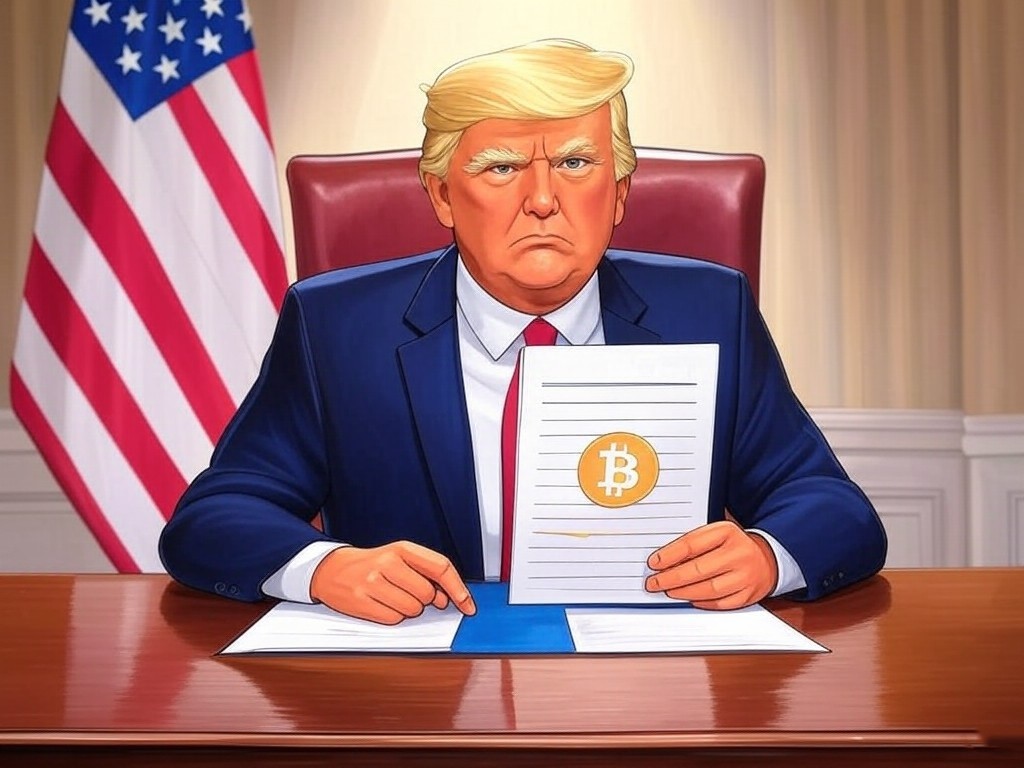0x12…qrst

Can a “crypto president” truly reshape the global financial system? U.S. President President Donald Trump’s administration is betting on it, with bold policy changes that include the potential for a national digital asset stockpile, a reversal of previous regulatory rules, and a clear intention to embrace digital tokens.
President Trump, in a rather expected move that has caught the crypto world’s attention, unveiled a series of policy changes signaling a major shift in how the U.S. will interact with digital assets. The announcement, made at the early days of his administration, have deep implications, hinting at a future where the government not only regulates crypto but actively participates in its growth.
For those who’ve been following the cryptic dance of government and cryptocurrency over the years, Trump’s new stance marks a dramatic pivot. As crypto has grown from an obscure digital curiosity to a multi-trillion-dollar industry, the U.S. has often felt like an onlooker, unsure whether to embrace or restrain this new economic force. With the signing of an executive order establishing the Presidential Working Group on Digital Asset Markets, Trump has now signaled a decisive shift, one that could change the course of the entire industry.
The executive order made headlines with its ambitious aim: to create a national digital asset stockpile. While still in its early stages, the potential ramifications are enormous.
Picture this: the U.S. government, akin to its control over gold reserves, accumulating and holding digital assets to stabilize the market. It’s a move that could dramatically shift the power dynamics within the crypto world.
For many crypto advocates, the idea of the U.S. government participating directly in the market is thrilling. If successful, it could cement the U.S. as the world’s leading crypto power.
But there’s a catch. Critics argue that this could undermine the very ideals crypto stands for — decentralization. The idea of the U.S. government stepping into the crypto space raises the question: will it become an empowering ally for digital assets, or a heavy-handed regulator?
But the national stockpile isn’t the only change. President Trump’s new crypto policies include a sweeping overhaul of how U.S. regulators, particularly the Securities and Exchange Commission (SEC), approach digital assets.
Gone is the restrictive Staff Accounting Bulletin 121 (SAB 121), which required firms to classify digital assets as liabilities. The SEC’s decision to rescind this rule is a welcome shift for the crypto industry, which has long been bogged down by regulatory ambiguity.
“The SEC’s repeal of SAB 121 is a huge win for both TradFi customers and DeFi users. Banks can now legally hold crypto, giving traditional finance customers secure access to digital assets while building trust in the space. For DeFi users, this opens the door for seamless integrations between traditional banking and decentralized solutions,” Mitchell Nishimura, Co-Founder & Co-CEO at Elys Network, said.
Adding to the excitement, the SEC appointed new leadership with a more favorable stance on crypto. Mark Uyeda’s appointment as acting chair is seen as a direct response to growing frustrations within the industry.
Under his leadership, the SEC is expected to take a more proactive, innovation-friendly approach. Industry insiders are hopeful that this will pave the way for clearer and more supportive regulations for digital assets.
And there’s more. The SEC has also created a new crypto task force, helmed by Commissioner Hester Peirce. Known for her advocacy of blockchain technology and her push for regulatory clarity, Peirce is seen as a champion of the crypto space.
The impact of these changes won’t just be felt in the U.S. As the world watches, the ripple effect of Trump’s new crypto policies is already being felt in global markets.
Countries that have been positioning themselves as crypto hubs — such as Hong Kong and Singapore — now face direct competition from the U.S. This shift signals that the U.S. is ready to reclaim its position as a global leader in cryptocurrency regulation and adoption.
And with David Sacks, a well-known crypto advocate, taking on the role of crypto czar, it’s clear that the U.S. is preparing to take a more active role in shaping the future of the industry on a global scale. Sacks’ appointment adds weight to the administration’s message: digital assets are here to stay, and the U.S. intends to be at the center of this financial revolution.
The ultimate success of these policies remains to be seen. The creation of a national crypto stockpile is still in its early stages, and the regulatory changes are still being rolled out.
But for the first time, the crypto world is watching with cautious optimism. The Trump administration’s stance on digital assets could be the spark that drives a wave of institutional investment and global adoption.
But as with all things crypto, the future remains uncertain. While the Trump administration is making moves to solidify its position, the path forward is fraught with challenges. Regulatory uncertainty, technological hurdles, and competition from other global markets will continue to shape the trajectory of this evolving industry.
It is clear that these regulatory developments could set the stage for the next chapter in the evolution of cryptocurrency. With a new focus on fostering innovation and ensuring the industry’s stability, the Trump administration is putting the U.S. in a position to lead in the digital age.